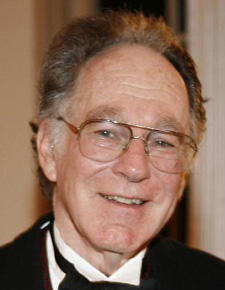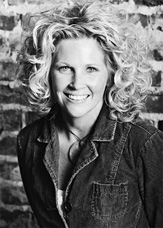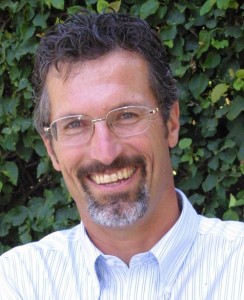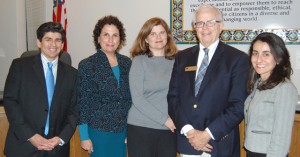Sipping green tea while schmoozing in Mandarin with Chinese Communist Party officials is a long way from shooting the breeze with buddies after surfing the waves at UCSB’s Campus Point, but it’s all in a day’s work for John Wood.
A former Peace Corps volunteer, Wood and his wife Lousia recently started the Tree House Scholarship for university students in rural, northwestern China. In addition to assisting students with their education costs, these scholarships will also help fund post-graduate travel for students who would not otherwise have the resources to explore their own country. These students, who are studying to become teachers, will be lucky to earn about $25 a month if they secure jobs when they graduate.
Writing about their experiences is another component of the program. The students come from incredible poverty. One tells the story of the deep bloody cracks in his father’s hands from collecting trash, while another writes of being raised in a cave house by a grandmother with bound feet. “They have phenomenal stories to tell,” says Wood, now 30
The stories of rural China in the 20th and 21st centuries remain largely unknown, both inside China and abroad, but Wood is aiming to change that by improving his students’ abilities to communicate and helping to get their stories out to the world.
“Because of the way that the government is structured and with the way people relate with each other, a lot of those stories haven’t been told,” he says. Even within families. For example, Wood tells the story of a student saying she felt uncomfortable asking her parents to talk about their backgrounds. “She went so far as to tell me that she didn’t even know her mother’s given name, she only knew her as mother.”
Using their “crazy foreign teacher” as a scapegoat, students came back with fascinating accounts of their lives. “These are really remarkable stories that we’ll publish and distribute to donors,” Wood says. “The idea is that people who are interested in China or just people that are philanthropic in general will be interested to read these first-hand accounts of what it’s like in rural China.” (http://www.thetreehousescholarship.org/students.html)
It’s no surprise that these stories struck a strong chord in him. Growing up in Goleta, Wood had passions for both writing and social justice from a very young age. “When I was going to La Patera Elementary School I remember I wrote an editorial (on gun control) for the ‘Goleta Sun,’ says Wood, who went on to graduate from Dos Pueblos High School and UC Santa Cruz.
He began his professional life teaching high school in South Central Los Angeles, and worked as a journalist in London, Santa Barbara and Santa Monica before joining the Peace Corps, where he was assigned to teach at Long Dong University in the eastern portion of Gansu Province. “Despite the sophisticated timbre of its name, Long Dong University actually has nothing to do with the entertainment industry,” says Wood. Gansu is one of the poorest provinces in China, and it is regarded among Chinese people as a dusty and barren frontier land, a “backwards” place best to be avoided.
The newlyweds arrived in China in June 2005 with assignments to teach English to Chinese students studying to be teachers. “There are more people studying English in China right now than there are native English speakers in the rest of the world combined,” Wood says. “It’s incredible; everybody in China, every single student is studying English. It’s just wild.”
Considered development work, Wood explains that he was primarily “in a classroom with future teachers and working with them to improve their English and improve their teaching skills. Most of our students had extremely basic grasp of English…we found ourselves spending a lot of time on basic pronunciation, on classroom presence, on building vocabulary, just really basic, basic stuff. When people think, ‘Oh John was a University Professor in China,’ what they have in their mind is probably not exactly how it was.”
And what’s it like being a 6′ 4,” Santa Barbara surfer dude in China? “There is absolutely no blending in,” laughs Wood. When visitors ask what kind of clothes to pack, he says, “you could bring a pink tuxedo and wear that down the street and you would not be anymore out of place than you are already going to be.”
Even though he’s stared at everywhere he goes, Wood says, “One of the things I love about China and Chinese people, there’s so little apathy and so much interesting curiosity and enthusiasm because here is a country that’s been closed to the outside world for so long…people know very little about Western China, and Western Chinese people know very little about the rest of the world and so it’s really a fascinating place to be.”
While China is booming, it’s the China of the eastern seaboard, of Shanghai and Beijing, Hong Kong and Guangzhou that most westerners read about. Wood says, “The reality is that the vast majority of Chinese people do not live in these eastern hubs. Some two-thirds of the population (estimated at 1.3 to 1.5 billion) still works the land. Most of the rest live in cities scattered across the vast provinces, earning very little and enjoying few freedoms.”
One of the freedoms not enjoyed in China is access to the news. “We call it the great firewall of China,” Wood says. “The Communist Party spends an inordinate amount of money on controlling Internet news sites…it’s not the news, it’s the good news.” Wood says he will sometimes be in the middle of reading a breaking news story online, only to find it censored (access removed) before his very eyes.
Despite the challenges of navigating such a different culture, the Woods are definitely making the most of their time in China. Last summer they volunteered with the 2007 Special Olympics World Summer Games in Shanghai. With their Peace Corps service now complete, Louisa works as the Communications Director for the Special Olympics East Asia, and John does translations and works export an extremely fast-growing, sustainable type of soft wood developed to reduce the demand on old-growth cedar and redwood.
Prior to founding the Tree House Scholarship, they also helped to establish “the Tree House,” at Long Dong University, an English library, study and discussion room, complete with all sorts of books, magazines and reference materials, as well as movies, music and board games to help students master the English language. A team of about 24 student volunteers keeps the Tree House running, and the materials–almost all which were donated by foreign teachers, their friends and families–in order. For information about how to donate books visit http://www.thetreehousescholarship.org/donors.html
He’s excited about the initial response to the Tree House Scholarship: “It was huge…a dozen or more people have already said they’re sending in checks and we’re already getting donations people who want to contribute pro bono services. It’s exciting.”
The new scholarship program isn’t the only exciting thing going on in Wood’s life. Louisa is expecting their first child, due to be born in a very modern Western style hospital in China, on Cinco de Mayo, which seems very fitting for this adventurous pair.
“We always joke about how nothing western seems foreign anymore. Europe used to seem so exotic, and interesting … now if I see an Italian news story and I see a police car and it says “polizia,” I just say to myself what could that possibly mean, as opposed to scribble scribble dot dot dash circle,” laughs Wood.
“Coming to China was a very intimidating thing to begin with, but we really just committed ourselves to it and it’s paid off hugely,” he says. “Martin Luther King Jr. once said that injustice everywhere is a threat to justice everywhere. We feel something similar could be said of poverty. Poverty anywhere is a threat to wealth everywhere. There are no national borders. And while there are those in the United States who suffer very real hardships, all of them have some degree of mobility, some degree of access to support networks, however humbling or hard to obtain those may be. The same is not true in China. The Chinese poor live in a tightly controlled and politically charged environment, with shockingly little power to change their futures.”








